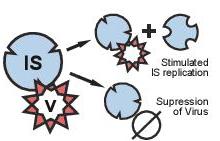Periodic versus intermittent adaptive cycles in quasispecies coevolution
Alexander Seeholzer, Erwin Frey and Benedikt Obermayer
Evolutionary dynamics has become a very active and innovative research field in theoretical physics, since it draws on and at the same time inspires new methods and concepts in statistical mechanics, nonlinear dynamics, and stochastic analysis. For instance, fitness landscapes can be mapped onto energy landscapes, co-evolutionary interactions between different populations such as predators and prey lead to nonlinear dynamics of population frequencies, and finite population sizes lead to stochastic noise.
These three aspects correspond to three main layers of evolutionary dynamics: different genotypes in a population compete on a fitness landscape, this landscape is nonlinearly modulated by the presence of other populations, and on top of that there is stochasticity. Usually it is hard or impossible to integrate all these features into a comprehensive model and most analyses consider on only one or two of them.
In our manuscript "Periodic vs. intermittent adaptive cycles in quasispecies co-evolution" we present a unified model, inspired by the co-evolution between mutating viruses and the adaptive immune system. By simulations and theoretical analysis, we show how the genotype level interacts with the population level, leading to novel error thresholds, and how nontrivial oscillatory dynamics is only induced by stochastic noise. Such oscillations can occur either in a regular fashion, or intermittently. Our analysis allows to precisely characterize where one type of dynamics crosses over to the other.
Our model starts from quasispecies theory, a well-established framework in theoretical biology, and adds two significant extensions: we include frequency-dependent fitness terms to model the interaction between virus and host, and we derive the deterministic quasispecies equations systematically from an underlying stochastic process. We can therefore combine traditional stability analysis with novel techniques to quantify stochastic effects in nonlinear systems. This so-called stochastic averaging is used to characterize the effective dynamics on the stable manifolds of a very high-dimensional system, and we show how stochasticity in finite populations is effectively suppressed by mutations.


